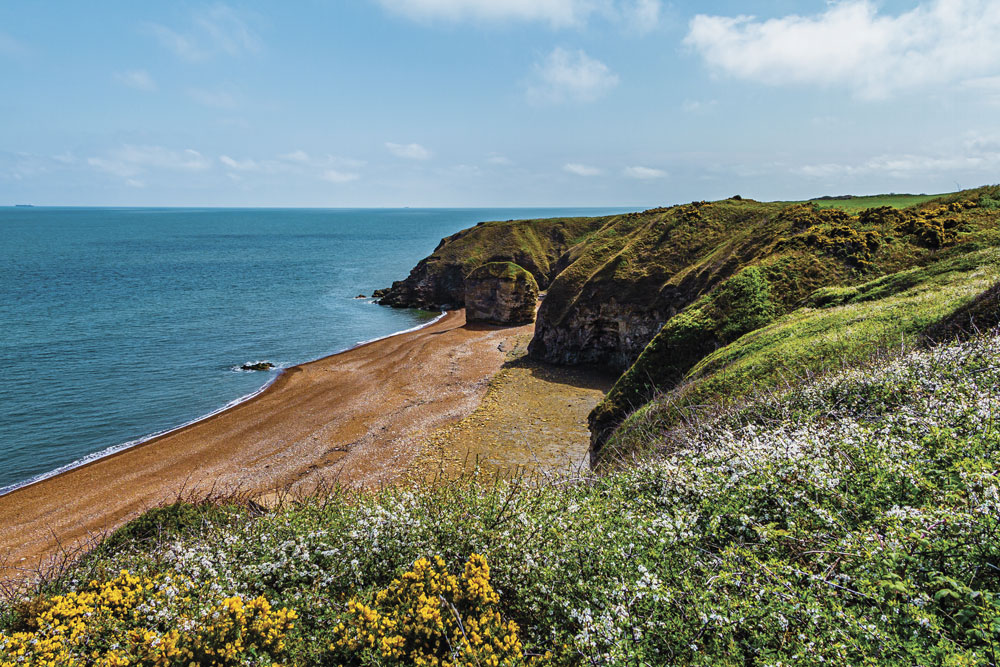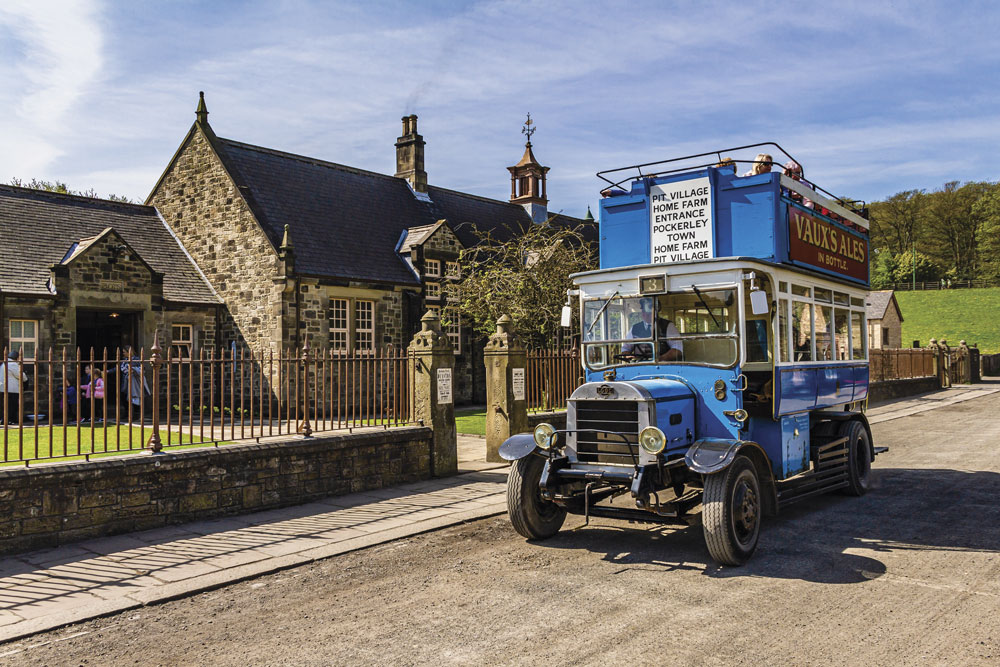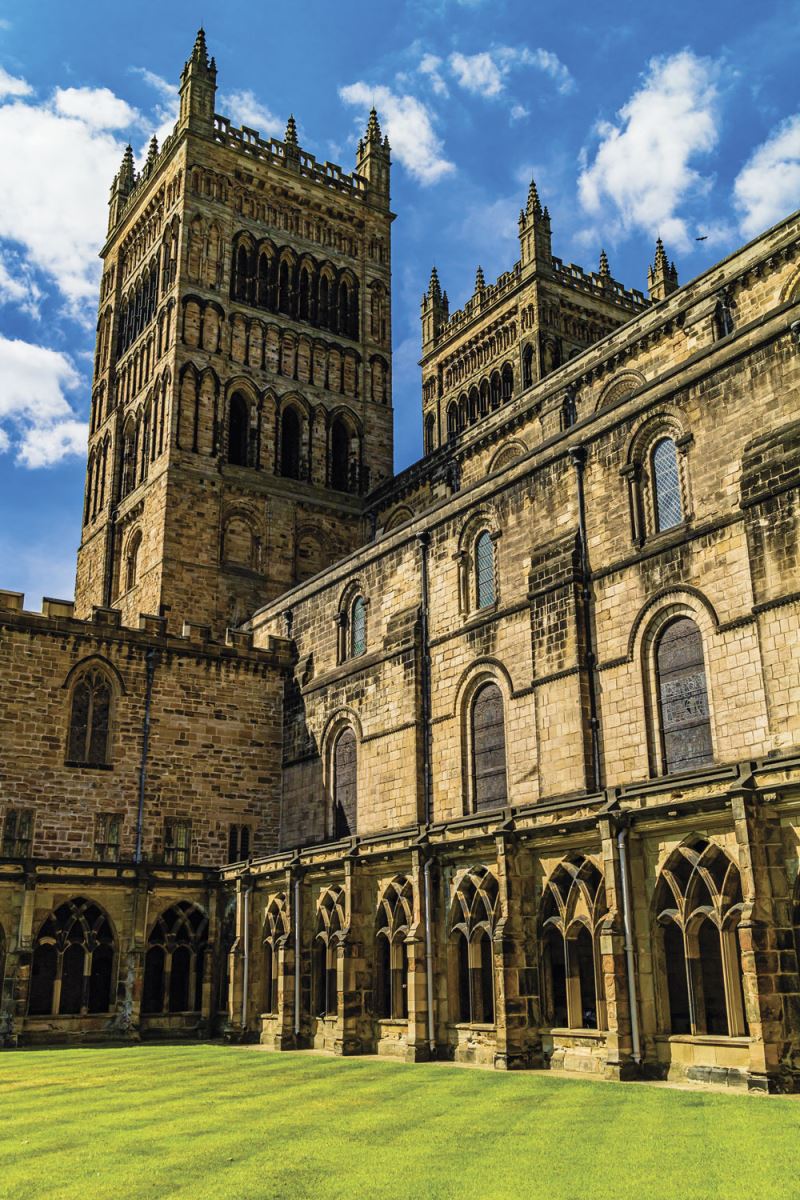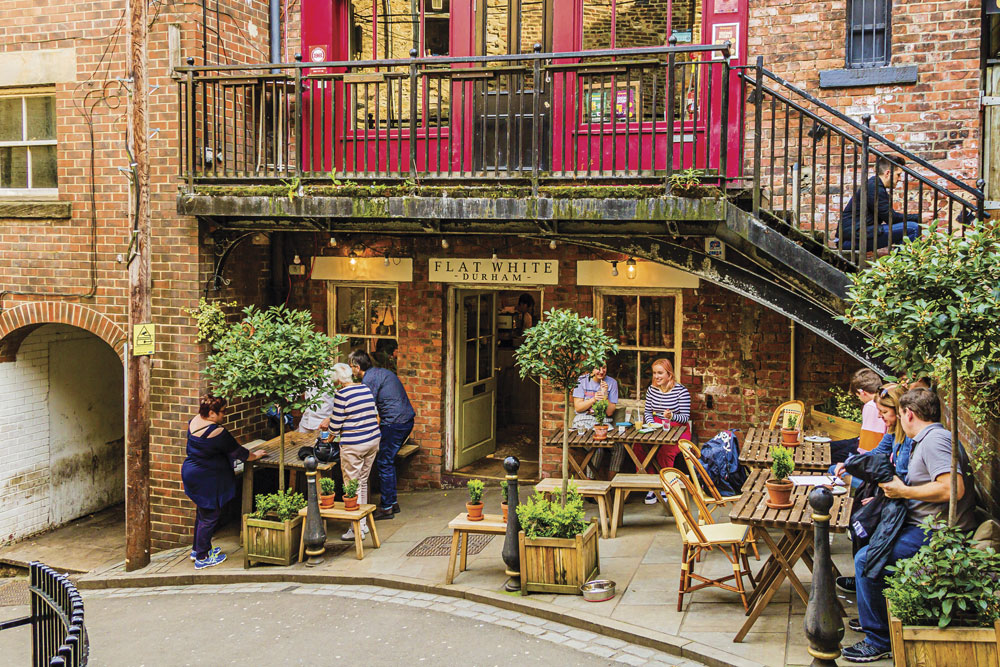Campervan and motorhome travel inspiration: Durham
See also: Campervan: Travel and Destination Guide
Words by Catherine Sheridan Photos by James Hodgson
This feature was written prior to the coronavirus pandemic. We are publishing it for your enjoyment and to help you plan your future trips. Readers most follow the latest government advice before leaving their homes. Consult www.gov.uk/coronavirus
Looking out over a calm, hazy blue sea from a clifftop rich in wildflowers, the air thick with the summer scent of warm gorse, it was almost impossible to imagine back even a few decades to the Durham Heritage Coast being a site of heavy industry – in fact one of the UK’s busiest coal mining areas.
Starting with the Romans, mining had peaked in the early twentieth century. As recently as the 1990s, huge conveyors were taking tonnes of mining waste from the land and delivering it directly into the sea – turning it and the shoreline black for miles.
We’d been to the cathedral city of Durham several times before, but the wider county sharing its name remained largely a mystery to us, its industrial heritage seeming at odds with the ancient beauty we’d seen so far.
Interested to learn more, we travelled in our campervan over a cross section of the county, from the coast to the Pennines.
Blast Beach, near Seaham

We started at Blast Beach, near the harbour town of Seaham, with the equally tellingly named Chemical Beach lying between the two. When the mines here closed in 1991 the coastline was used as a location for the film Alien 3 such was its state of desolation.
It was still a bit otherworldly down on the shingle beach. Sea stacks stood in solemn towers along the tideline and bright red and orange pebbles shone among patches of dark sand at our feet.
We caught the odd whiff of something metallic and noticed rust-tinged pools along the base of the cliffs, but it didn’t seem to be putting off the many nesting seabirds who had found shelter beside bricked-up mine entrances.
We looked out for bits of sea coal that we’d heard still turn up on the beaches after stormy weather and found occasional blue gems of seaglass left over from a Victorian bottleworks that had been another of the many industries here.
Since the mine closures and the alien landings, a major clean-up of this stretch of coast has taken place and it is now in National Trust ownership. Access to the clifftop path has been improved as part of the England Coast Path and the limestone grassland provides a rare habitat rich in wildflowers.
We spotted wild pansies, strawberry plants and orchids, while longer grass full of cowslips was gearing itself up to soon become a hay meadow.
Half-an-hour inland, one pit village was still very much in full swing. “When my husband comes home from the mines, he has the bed and I might have up to 20 children asleep in the attic on straw mattresses,” a woman in 1900s period dress told us at Beamish, The Living Museum of the North.
Visiting Beamish, the Living Museum of the North

“Between stoking the fire, washing, cleaning, cooking, feeding the baby and weaning another, I might get an hour’s sleep on the chair when I can. Many women die from exhaustion.” The row of cottages where she was working had been relocated from Hetton and now stands alongside a soot-blackened church and schoolhouse.
Beamish sits in a dip surrounded by hills, a collection of buildings either bought whole when threatened with demolition or pieced together from unrelated bits found in reclamation yards. There is even a former Newcastle city tram and we joined an excitable queue climbing up to the open-top level, before embarking on the 20-minute round journey of the site.
As well as the pit village, Beamish is home to an Edwardian high street full of shops and services. There, a dentist explained her gruesome-looking tools were actually state-of-the-art equipment. They included not only cloves for pain relief, but also gas for those brave enough to risk an unmeasured dose. Next door we called in at a pub and confirmed that some good things haven’t needed to change so much.
Beamish also has its own mineshaft and a short section is open to visitors. We put on hard hats, crouching to walk through the damp tunnel, our eyes slowly becoming accustomed to the dark while our muscles started to ache.
Stopping at a section of coalface, our guide told us how the dangers of the job strengthened communities. Even in the 1980s, in his previous job in a working mine, he’d only narrowly avoided being drowned by a sudden influx of water – despite the help of modern surveys and safety equipment, let alone 100 years earlier in mining’s heyday.
Back outside, a guide in a sooty flat cap was tending an allotment beside the row of cottages. He paused to tell us how he’d grown up in Hetton and delivered newspapers to these very buildings when they’d been in situ. There’s no questioning the local knowledge of the guides here, though it helped to distinguish between real anecdote and role play. The woman stoking the fireplace presumably went home to a proper bed at the end of the day!
Taking a tram again we called at Pockerley Old Hall, a Georgian country house where hens dozed in the sunny yard and windows offered views over landscaped meadows to a peaceful church. From here we went for a short ride on a replica of Puffing Billy, one of the world’s first steam engines and built in the northeast. Though not fast, it was still exhilarating, its many pistons and levers cranking and belching steam as we trundled along.
Taking us back further in time, whilst simultaneously back to the present, was Durham, its ancient city centre busy with students relaxing after exams. We approached the city from Framwellgate Bridge, with its impressive view of the cathedral above the curving River Wear.
The city of Durham, cathedral and all

From there we followed hilly cobbled streets to its door. Entering through a dog-toothed crypt containing the tomb of the Venerable Bede, we bought tickets to join a guided tour gathering among the columns. Another tomb contained St Cuthbert, one of the most important saints of medieval northern England who, in the seventh century, lived as a monk on the Northumbrian island of Lindisfarne.
Quite eye-catching, he is often pictured holding either ducks or St Oswald’s head or having his feet breathed on by otters to warm them following prayers in the North Sea.
We learnt that it was St Cuthbert who chose the site for Durham cathedral (although posthumously). Following Viking raids on Lindisfarne, the monks there had fled and taken St Cuthbert’s coffin with them and spent a couple of hundred years roaming around with it until settling on the easily defended outcrop later to become Durham; the story goes that the coffin became too heavy to move any further.
A succession of simple churches were built to house it and, following 1066, the Normans built a castle before going all out in a display of power and piety and deciding to build the cathedral. Not ones for frivolities, its scant decoration put there mainly to help its builders place the stones, it is now UNESCO World Heritage listed for being the largest and most perfect example of Norman architecture in England.
In the woods below the cathedral, we followed a riverside footpath while, on the water, university rowers overtook us and we overtook clumsier leisure boats. A man watching the opposite bank told us he was looking for otters (he still had his shoes on!), but the noise from the rowers was probably keeping them away.
Some particularly graceless rowers looked like they were having a good time, so we found the boat hire at Elvet Bridge and spent an hour out on the wonderful river ourselves.
A little surprised at then needing a respite from the sunshine, we headed to the nearby Victoria Inn. Built in 1899 and more or less unchanged since, it is listed for its historic interior where a magnificent metal till sits behind the bar surrounded by Toby jugs and decorative china whisky barrels.
Next stop was the area of the North Pennines known as the Durham Dales. We joined the River Tees at Barnard Castle where we stopped for a look around. It’s an upbeat market town with grand Georgian buildings full of busy local shops alongside quieter tree-lined streets, where horses and carts passed by on the final stages of their journey to Cumbria’s Appleby Horse Fair.

Founded by the Normans and a contemporary of Durham Cathedral, Barnard Castle was built to suppress local rebellions and the town grew around it. Its spectacular ruins are on an outcrop above the river and we took a footpath down to the water, which moved slowly over gravel banks and rocks that were remnants of its hill stream origins. The Teesdale Way took us further along the riverbank before looping back into town and we continued up the valley in the campervan.
The road rose high along the valley side, with views of limestone escarpments and the softening lower slopes criss-crossed with dry stone walls surrounding ancient squares of hay meadow. We stayed at Leekworth Caravan & Camping Park, a farm in a fantastic position inside the meander of the tree-lined Tees.
A partly cobbled riverside path – a continuation of the Teesdale Way – ran from the campsite into the nearby village of Middleton-in-Teesdale.
Further up the Tees still is High Force, one of England’s most impressive waterfalls, which drops over 60ft into the gorge it’s gradually eroded. We walked a section of the Pennine Way to include downstream Low Force, which led back up the river through the edge of the Moor House – Upper Teesdale National Nature Reserve.
Designated early on in 1952, the nature reserve contains a wide range of upland habitats and includes plants that were early colonisers of Britain after the last ice age. The range of wildflowers was extraordinary, with many of them new to us.
As we neared the waterfall we found ourselves in a juniper wood, the hardy shrub-like trees allowing only the sound of the crashing falls through. We didn’t get a glimpse until we reached a clifftop viewpoint, a sheer drop in front of us offering a wonderful view of the waterfall.
We drove home over the high moorland, travelling slowly to take in views and avoid sheep. The abandoned remains of mines were dotted around, villages that had been built to house the miners of lead, fluorspar and iron deposits that ran through the hills.
County Durham had proven to be diverse; its mining history more ancient than its millennia-old architecture, its pockets of nature some of the most ancient and rarest of all.
The journey to Durham
Taking the A1 south from home in Northumberland, we spent six days exploring County Durham. From the coast at Seaham, we headed inland on the A688 up Teesdale before taking the A68 back to the A1.
The costs
Fuel average, 36mpg: £29
Site fees: £112
Attractions, two adults Beamish Museum, Durham Cathedral tour, boat hire, High Force: £66
Parking: £2
Total: £209
Useful information
2020 is Durham's Year of Pilgrimage thisisdurham.com
Durham Cathedral is free to enter, but the £5 guided tour gave us more of an insight durhamcathedral.co.uk
Beamish Museum easily fills a whole day. The tickets allow you to return as often as you like over a year beamish.org.uk
This trip took place prior to the coronavirus pandemic. We are publishing it for your enjoyment and to help you plan your future trips. Read the latest camping travel advice here.
Expert Campervan advice to your door!
Campervan is the exciting monthly magazine that will give you all the inspiration you need to explore the world in your campervan. Every issue is packed with real-life campervanning experiences, inspiring travel ideas in the UK and further afield, the best campsites to stay on, campervan road tests and reviews of the latest models, and much more!
Want to know more about Campervan Magazine?








Recent Updates
Engine management lights: all you need to know
What is the engine management light? What does it mean, and what do I have to do? ...
Motorhome air suspension: all you need to know
Motorhomes are heavy and the additional weight of equipment and height of the bodywork can increase the loads ...
Motorhome WiFi: how to get better motorhome internet
Staying connected on the move is more and more essential, so relying on campsite WiFi isn't an option – here ...
A class of their own - our guide to A-class motorhomes
Thinking of trading up to an A-class, or even going straight to the top of the motorhome tree? We guide you ...
Explore overseas on a motorhome dream tour
Enjoy exotic travel in a campervan or motorhome by hiring, swapping with someone else or exporting your ...
Motorhome water systems: everything you need to know
On-board water is an important part of every motorhome – here’s everything you need to know ...
Campervanning in Europe: what you need to know
Whether you're planning a leisurely drive through the French countryside, navigating bustling city streets in ...
Campervan security: all you need to know
With thefts on the increase, it’s important to know how to keep your campervan secure and prevent campervan ...
Campervan furniture: everything you need to know
Our campervan experts guide you through all the essentials for your campervan, including tables, chairs, ...
Campervan finance: how to fund your purchase
Here we look at the different types of campervan finance available, to help you decide what’s the best option ...
Other Articles
Britain’s best used motorhomes
Want a great motorhome without paying the premium for a new one? Here's a guide to the best you can get in the pre-owned market for each layout, ...
Which motorhome? Choosing the perfect motorhome for you
Choosing a motorhome or campervan is one of the biggest buying decisions you’ll ever make, so it's important ...
Campervan washroom essentials: stay fresh on the road
Our guide will take you through the campervan washroom essentials you'll need so you're well-prepared for ...
Dogs in campervans: all you need to know
Follow our advice and your dog will enjoy campervanning as much as you do ...
Electric campervans: all you need to know
Our guide will take you through everything you need to know about electric campervans and what the future ...
Motorhome electrics: a complete guide to your motorhome electrical set-up
Motorhome electrics can dramatically enhance the convenience and comfort of your vehicle – but they can be ...
Lighting for campervans: all you need to know
We guide you through all the lighting options available for you and your campervan, including interior ...
Electric bikes for motorhomes: our ultimate guide
Read our comprehensive guide to electric bikes for motorhome owners, helping you add electric power to your ...
Our guide to 'cheap' motorhomes in 2024
If you're on the hunt for an affordable new motorhome, this is the best place to start – we've rounded up a ...
Campervans in winter: all you need to know
Here's your guide to preparing your campervan for the colder months, whether you will be using it or putting ...